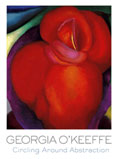
Perhaps O'Keeffe's most emphatic statement of her individuality during the 1940s was the extended series of paintings of pelvis bones that she began in 1943. These canvases signaled a new direction for the artist: they differed significantly from both the spiraling vortices of her earliest abstractions and the emphatic volumes of her pared-down subjects of the 1920s and 1930s. From the beginning, it was also apparent that the true subject of this series was not potential symbolism of bone itself, but rather the impact that could be generated by using its hollow sockets-its voids-as a lens through which to view the infinite reaches of the desert sky.
Despite the ways in which O'Keeffe's art diverged from that of most other avant-garde painters prior to the early 1940s, it often shared with theirs the qualities of refinement, clarity, and control, as well as the relatively small scale of traditional easel painting. The persistence of these qualities in O'Keeffe's work placed it in direct contrast, however, with the increasingly nonrepresentational, energetically painted, large-scale canvases of America's new generation of avant-garde artists, such as Jackson Pollock and Willem de Kooning.

